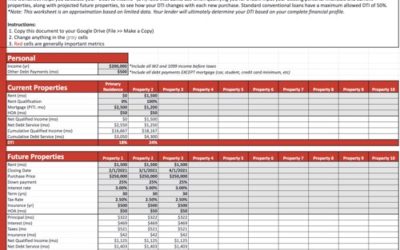Buying or investing in new homes is exciting, and quite often builders have pretty attractive incentives for bringing you in. Offers like… “$10,000 discount”, “$5,000 closing cost allowance”, “No lender fees”, “We pay your title policy”, etc. What their ads almost always fail to mention are that these offers are almost always tied to THEIR preferred lender. So the question ultimately becomes… is this a “good deal” or not. To answer that, you have to understand the fundamentals of how the lending business works.
There’s no free lunch
Lenders are in the business of making money, and as typical with most lenders, they will immediately sell your loan on the secondary market (the behind the scenes market where loans are traded like stocks) shortly after closing. Since they don’t hold your loan to collect the interest, the two primary sources of revenue are loan/lender fees and margin when they sell the loan. They partner up with builders to generate leads, which in turn generate more loans and therefore more revenue. Now you’re probably thinking: “But the ad says no lender fees”. You’re right, and you won’t pay these fees. What you WILL pay is a higher rate to make up for these fees. This is true of any loan from any lender. You can get a lower rate and pay extra at closing, or take a higher rate and get a credit at closing. What’s happening in the builder’s lender case is you are effectively taking a higher rate that then offsets your lender fees, title policy, etc. In other words, there are STILL all of these fees, you’re just paying for them a different way… over time. The reason this is profitable for the lender is when they go to sell your loan, they will receive a higher margin for that loan because of the higher rate you locked in. Meaning… whoever ultimately ends up with your loan gets to collect all of that extra interest over time, and therefore will pay a higher premium for the right to collect that interest.
So is it a good deal?
First you have to compare apples to apples. If you have your own preferred lender, give them the deal the builder is offering and see if they can match it. Sometimes they are able give you the same amount of credit at closing (to offset the loan fees, title policy, etc) and still have a lower rate. Sometimes they can’t… but it never hurts to ask.
Actually…. lunch can be free
But you’re going to have to do some work to get it. When a lender sells your loan, the buyer of that loan is banking on the fact that you’re going to stick with that loan and make lots of interests payments over time. Now, although they may hate it, there is nothing preventing you from refinancing that loan immediately after you open it. This effectively gives you the best of both worlds… the “great deal” from the builder, and a decent rate over time. Now… you’ll still have to pay loan fees associated with your refinance, but those will be with your preferred lender, so presumably they will be lower and with a better rate. You can also take a slightly higher rate (still lower than the one with the builder’s lender) and cover the costs completely. Additionally, title policies are usually significantly cheaper if you just purchased one within a short period of time.
So how should you play it?
Take the builder’s lender deal to your preferred lender first. They will help level the playing field and give you a true apples/apples comparison. If they can beat it, go with your lender. If they can’t, go with the builder’s lender and refinance with your preferred lender immediately after closing. If you’re fast enough, you may even be able to delay your first month’s payment another month or two!





